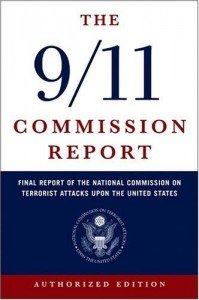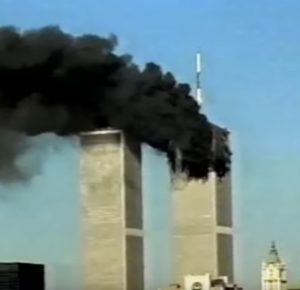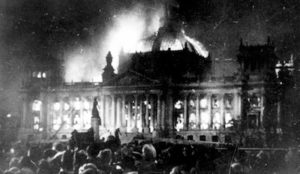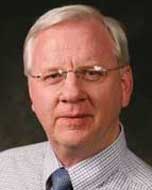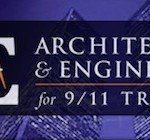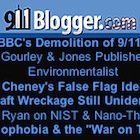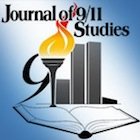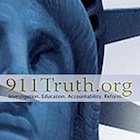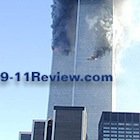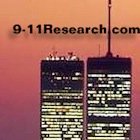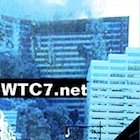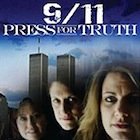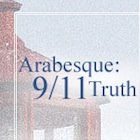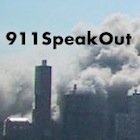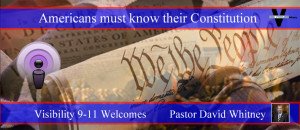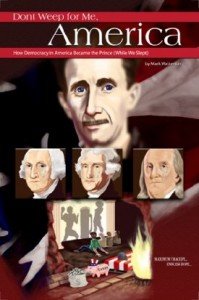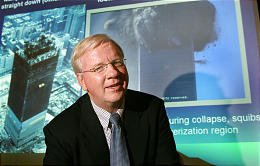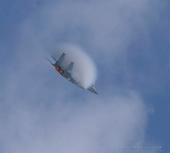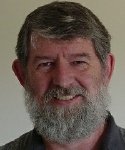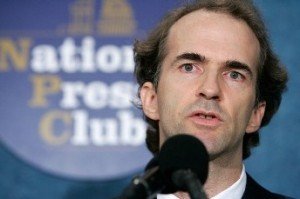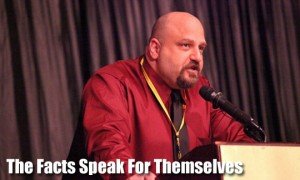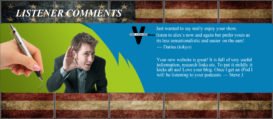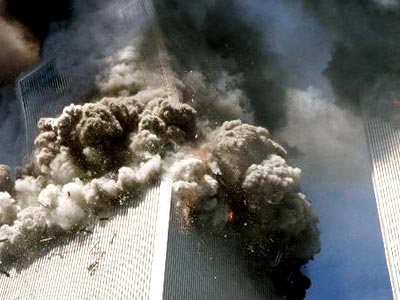 A number of individuals who worked in key positions apparently knew that the Twin Towers of the World Trade Center were going to collapse before the two buildings came down on September 11, 2001. These men talked with colleagues about their concern that the towers might come down, and some of them issued stark warnings about the danger and ordered people to get away from the World Trade Center.
A number of individuals who worked in key positions apparently knew that the Twin Towers of the World Trade Center were going to collapse before the two buildings came down on September 11, 2001. These men talked with colleagues about their concern that the towers might come down, and some of them issued stark warnings about the danger and ordered people to get away from the World Trade Center.
Although their warnings have, in some cases, been credited with saving lives, the behavior of these men is, on closer examination, surprising and quite suspicious. This is because the general opinion before September 11 was that the Twin Towers would survive being hit by planes and the outcomes of previous high-rise fires should have led the men to think the towers would easily endure the fires they suffered on September 11 without collapsing.
Studies, which many firefighters and experts were aware of, had determined that the Twin Towers would withstand being hit by large jet aircraft. Furthermore, no steel-framed high-rise building had ever collapsed due to fire before 9/11. Steel-framed skyscrapers, like the Twin Towers, had survived fires that were larger and burned for longer than those that occurred on September 11. Unsurprisingly, then, it never occurred to most experts and most of the firefighters who responded to the plane crashes at the World Trade Center that the towers were in danger of coming down.
If the collapses of the Twin Towers occurred without the use of explosives, as official accounts have claimed, then these events were unprecedented. Nothing remotely like them had happened before. Why then did some experts and emergency responders warn–sometimes with great conviction–that the towers were going to collapse?
We clearly need to examine why these men predicted that the Twin Towers would come down after the hijacked planes crashed into them on September 11, especially since some of them had specific expertise or professional experience that should have made them less likely than most people to anticipate the collapses.
DID THE MEN WHO PREDICTED THE COLLAPSES HAVE FOREKNOWLEDGE OF 9/11?
Did the men who thought the Twin Towers were in danger of collapsing just possess remarkable foresight, such that–unlike their colleagues and many experts–they were able to predict events unlike anything that had ever happened before? Or might some, or all, of them have had at least a degree of foreknowledge of what was going to happen on September 11? Did any of them know that there was going to be a terrorist attack that day, during which the Twin Towers would collapse?
If this was the case, it would surely mean the towers were brought down with explosives that were planted before September 11. And the men who warned that the towers were going to collapse must have known, or learned enough to suspect, that explosives had been planted in the buildings.
If the towers were brought down with explosives, it would mean that the official account of 9/11 is wrong. Secretly preparing the World Trade Center to be demolished would have been a sophisticated and complex operation, way beyond the capabilities of Osama bin Laden and his al-Qaeda terrorist network. The involvement of powerful, well-placed, and knowledgeable people would be necessary to obtain the materials required for the demolitions, evade security at the Trade Center, and plant the explosives. The plotters must have included rogue individuals in the U.S. military and other government agencies.
We need to consider how the men who warned that the Twin Towers were in danger of collapsing might have learned about what was going to happen on September 11. It is plausible that at least some of them knew what was going to happen because they were part of the group that planned the 9/11 attacks. However, since these men appear to have been trying to save lives on the morning of September 11 and, in some cases, put themselves at great risk as they responded to the attacks, this seems unlikely.
Alternatively, the men could have been coerced into helping the perpetrators of 9/11 plan and prepare for the attacks due to their job positions or because of expertise they possessed, and could have gained some knowledge of what was going to happen on September 11 while they were reluctantly giving their assistance.
Or perhaps the men were tricked into assisting the perpetrators without realizing they were helping with the preparations for a terrorist attack. They may, for example, have been invited to help carry out what they thought was a study to examine the vulnerability of the World Trade Center to a terrorist attack. The study, however, could in reality have been intended to help those behind 9/11 plan the attacks. Among other things, it could have helped them work out how to bring down the Twin Towers with explosives and how to evade security so as to plant explosives in the towers.
If this is what happened, the men may suddenly have understood how they had been deceived when they learned that planes had crashed into the World Trade Center on September 11. They may then have realized, based on the content of the study they had been involved with, that the Twin Towers were probably going to be demolished as part of the attacks. And upon this realization, they could have decided to try and save lives by alerting people to the impending collapses.
In this article, I describe the actions of several men who thought the Twin Towers were going to collapse before the buildings came down. I also look at evidence that shows the towers should easily have withstood being hit by planes and suffering major fires. In light of this information, it seems inexplicable that any knowledgeable professional could have confidently predicted they were going to collapse. Indeed, as I reveal, most experts and emergency responders assumed that the towers would remain standing after the hijacked planes crashed into them.
I discuss various ways in which the men who believed the Twin Towers might collapse could have learned what was going to happen on September 11. And I describe the particular knowledge and experience some of them had, which may have prompted those behind 9/11 to seek them out and make use of their expertise when planning the attacks.
SENIOR OFFICIALS AND A DEMOLITIONS EXPERT WARNED ABOUT THE COLLAPSES
At least six men explicitly warned that the Twin Towers were going to–or at least might–collapse before the buildings came down. These were Lieutenant Joseph Torrillo, director of the New York City Fire Department (FDNY) Fire Safety Education Unit; an engineer with the New York City Department of Buildings; Mark Loizeaux, president of Controlled Demolition Inc., a company that specializes in using explosives to make buildings collapse; Captain Anthony Whitaker, the commanding officer at the World Trade Center for the Port Authority of New York and New Jersey Police Department (PAPD); Peter Guidetti of the FDNY; and Deputy Chief Ray Downey of the FDNY.
DIRECTOR OF FIRE SAFETY EDUCATION WARNED PEOPLE TO GET AWAY FROM THE TWIN TOWERS
Lieutenant Joseph Torrillo, a former firefighter, was, at the time of the 9/11 attacks, director of the FDNY Fire Safety Education Unit, which teaches fire prevention and survival to various establishments, such as schools and senior citizens’ centers. His behavior on September 11 is notable for the conviction with which he repeatedly warned people that the Twin Towers were going to collapse and his dogged efforts to get people away from the towers.
On the morning of September 11, Torrillo was at his office at FDNY headquarters in Brooklyn when he was informed that a plane had crashed into the World Trade Center. (That plane, American Airlines Flight 11, hit the North Tower at 8:46 a.m.) After seeing the burning North Tower on television, he headed out with three fire cadets and drove toward the Trade Center.
From about an eighth of a mile away from the center, Torrillo could see what appeared to be eight to 10 floors of the North Tower on fire. One of the cadets asked him, “What do you think?” and, with remarkable prescience, he replied: “Everyone on the top of that building is going to die! That building is going to collapse! Today will be like no other day anyone ever remembered about New York City!”
Torrillo drove to his old firehouse, across the street from the Twin Towers. After putting on some firefighting clothing, he ran toward the South Tower, reaching the building as the second hijacked plane, United Airlines Flight 175, crashed into it at 9:03 a.m. He then ran toward the North Tower.
“As [I was] running toward the North Tower … one of [the] things [I was] saying to myself [was] that these buildings [were] going to collapse and that [I had] to let a lot of people know about it,” Torrillo recalled. “It was very obvious to me that those buildings were going to collapse. … I was positive,” he said.
Outside the North Tower, Lieutenant Anthony Mancuso, a friend of Torrillo’s from the FDNY, pulled up near Torrillo and asked, “What’s going on?” Torrillo replied: “Tony, look! Those buildings are going to collapse!” He also said, “We’re going to lose all of the water around the Trade Center” and told Mancuso, “Take your engine and go about six blocks north, connect to a hydrant there, and bring the hoses back so we’ll have water if we lose it here.”
Torrillo then repeated his warning, saying: “Listen to me! These buildings are going to collapse!” Mancuso took Torrillo’s advice and moved his unit six blocks north. Perhaps at least partly due to Torrillo’s warning, all of Mancuso’s crew survived the collapses of the Twin Towers that day.
Torrillo then ran to the corner of Liberty and West Streets, where he stopped ambulances that were heading to the World Trade Center from the Brooklyn-Battery Tunnel. He again warned that the Twin Towers were going to collapse, telling the drivers of the first two ambulances that the buildings would fall and they should make a U-turn, go back toward the tunnel, and park at the curb. The drivers passed Torrillo’s instructions on to the other ambulances.
Ladder Company 113 pulled up by Torrillo and Lieutenant Ray Brown asked, “Joe, what’s going on?” After explaining the situation, Torrillo said: “Go back! Go back now!” Brown took Torrillo’s advice and moved his ladder company about 100 feet away. All of the crew subsequently survived the collapses of the Twin Towers.
FIRE SAFETY EDUCATION DIRECTOR THREATENED TO DRAG PEOPLE OUT OF THE SOUTH TOWER IF THEY DIDN’T LEAVE
Torrillo then noticed that, against his advice, an ambulance was racing toward the South Tower. He went and confronted the man in charge of it. The man retorted: “You don’t have any authority! We don’t work for you! We’re going to set up a triage center in the lobby of the South Tower!” Torrillo warned him: “That building is going to fall! Get out of this building right now!”
An emergency medical technician angrily said, “No!” and asked, “Who the hell are you?” Torrillo responded, “Either you get out of here or I will drag you out of here!” He instructed the members of the ambulance crew to set up a staging area about three blocks away from the Twin Towers. Finally, the men accepted his advice and drove away. Torrillo may have saved their lives because then, at 9:59 a.m., the South Tower collapsed. [1]
Despite his efforts to warn others, however, Torrillo was caught in the collapse himself and suffered serious injuries from being hit by debris from the tower. [2]
Torrillo has claimed that he thought it would take five or six hours before the Twin Towers came down. [3] He believed any collapse was “going to happen at two or three o’clock in the afternoon,” he said. [4] However, if this is true, why did he instruct firefighters and ambulance crew members to get away from the towers immediately? Surely if he thought the towers would remain standing for five or six hours, he would have wanted emergency workers to respond normally while the buildings were stable and when their help at the World Trade Center was most urgently needed. He could have just warned emergency responders that they would need to get away from the towers later on, when, he claimed, he feared the towers were going to collapse.
Torrillo also said he believed only the top floors of the towers–not the entire buildings–would come down. “I knew the amount of the fire would cause the tops of the buildings to twist and buckle,” he commented. [5] But if this was the case, surely he could have just told firefighters and other emergency responders that they would need to remain inside the towers, where they could carry out their crucial work while staying safely away from any debris that would fall outside if the top floors came down.
Torrillo’s behavior, therefore, indicates that, contrary to what he claimed, Torrillo thought the collapses were imminent and would involve the buildings coming down completely, which would mean he had an accurate idea of what was going to happen that morning.
ENGINEER THOUGHT THERE WAS AN ‘IMMINENT DANGER OF COLLAPSE’
An unnamed engineer with the New York City Department of Buildings, like Torrillo, confidently predicted that the Twin Towers were going to collapse. Emergency Medical Service Division Chief John Peruggia recalled being alerted to the danger by this person while he was gathered with other emergency response officials in the lobby of World Trade Center Building 7, about 350 feet north of the Twin Towers.
Sometime after the second hijacked plane crashed into the World Trade Center, one of these officials–an “engineer-type person” from the Department of Buildings–said that “it was believed that the structural damage that was suffered to the [Twin] Towers was quite significant and they were very confident that the building’s stability was compromised,” Peruggia described. “They felt that the North Tower, which was the first one to be struck, was going to be in imminent danger of collapse,” he added. (The North Tower, however, was the second tower to collapse, coming down 29 minutes after the South Tower.)
Peruggia grabbed Richard Zarillo, an emergency medical technician, and instructed him to go to the command post across the street from the North Tower and pass on the engineer’s warning to Peter Ganci, the chief of the FDNY. Zarillo was to tell Ganci that “the building integrity is severely compromised and they believe the building is in danger of imminent collapse.” [6]
Zarillo went to the command post where he passed on Peruggia’s message to Fire Marshal Steve Mosiello, Ganci’s executive assistant, and then to Ganci. Although Ganci was surprised at the warning, about 30 seconds after he received it the South Tower started to collapse. [7]
DEMOLITION ENGINEER TRIED PHONING PEOPLE TO WARN THEM ABOUT THE IMMINENT COLLAPSES
Another person who confidently predicted that the Twin Towers were going to collapse was Mark Loizeaux, president of Controlled Demolition Inc., a company based in Phoenix, Maryland, that specializes in using explosives to bring buildings down.
Loizeaux recalled that when he saw the Twin Towers had been hit by planes, he knew right away they were going to come down. [8] He told his brother, Doug Loizeaux, the vice president of Controlled Demolition Inc., of his concern. “I told Doug immediately that the [North] Tower was coming down and when the second tower was hit, that it would follow,” he said. [9] Loizeaux predicted that the South Tower would be the first building to collapse, even though it was hit by a plane 17 minutes after the North Tower was. “The second tower will fall first, because it was hit lower down,” he said. [10]
After seeing the second crash on television, the two Loizeaux brothers tried, initially without success, to alert people to the danger. Mark Loizeaux told his colleagues, “Start calling all the cell phones; tell them that the building is going to come down.” [11]
He wanted to contact the FDNY to tell it to pull its firefighters out of the Twin Towers. “I picked up the phone, dialed 411, got the number, and tried it,” he recalled, but the line was busy. He then tried phoning the Mayor’s Office of Emergency Management, in World Trade Center Building 7, but again was unsuccessful. “All circuits were busy; I couldn’t get through,” he said. [12] He was, though, able to contact a couple of members of the National Research Council committee that was involved in assessing the impact of explosives, to warn them about the impending collapses. [13]
Loizeaux has claimed, since 9/11, that the Twin Towers came down due to the damage they suffered from being hit by planes and the ensuing fires. [14] And yet, if this is what he believed, why did he promptly call members of a committee that was involved in assessing the impact of explosives, following the crashes at the World Trade Center? Might it have been because, in truth, he thought there were explosives in the towers that were going to be used to bring the buildings down?
POLICE CAPTAIN TOLD HIS MEN TO STAY OUT OF THE TWIN TOWERS, AS THEY COULD COLLAPSE
Captain Anthony Whitaker of the PAPD was one of several high-ranking officials who thought the Twin Towers were in danger of collapsing on September 11. As the commanding officer at the World Trade Center, he was responsible for all PAPD officers assigned to the center. [15]
Two PAPD officers, Sergeant Quentin DeMarco and Daniel McCarthy, recalled Whitaker telling them the Twin Towers might collapse. DeMarco encountered Whitaker at the PAPD mobile command post, across the street from the North Tower, shortly before the first tower–the South Tower–came down. Whitaker told him that “no one is to enter the buildings,” he said, because “they were structurally compromised and could collapse.” [16]
McCarthy was also at the mobile command post at the time. He recalled that Whitaker arrived “and advised all members of the department who were present not to enter the building.” Whitaker told his men: “That building is not stable. I don’t want any more of our guys going in there.” McCarthy commented that he “strongly” believed Whitaker “was instrumental in saving the lives of approximately 40 more police officers” by issuing this warning. [17]
After the South Tower came down, at 9:59 a.m., Whitaker warned people that the North Tower was also going to collapse. Joseph Morris, another senior PAPD officer, recalled that after the South Tower collapsed, Whitaker told his colleagues at the mobile command post, which was still parked across the street from the North Tower, “We have to get out of here.” Morris asked, “Why?” and Whitaker replied, “The first tower came down and this [i.e. the North Tower] is going to come down too.” [18]
Whitaker may have warned that the North Tower was going to collapse because he believed that since it was enduring the conditions–damage from a plane crash and fires–that apparently caused the South Tower to come down, the North Tower would likely suffer the same fate as the South Tower. But it is also possible that he issued the warning because he had foreknowledge that the North Tower was going to collapse.
POLICE CAPTAIN PROMPTLY ORDERED THE EVACUATION OF THE ENTIRE COMPLEX
Whitaker also exhibited considerable foresight by ordering the evacuation of every building in the World Trade Center complex in the time between Flight 11 crashing into the North Tower and Flight 175 crashing into the South Tower. This meant evacuating not just the Twin Towers, but also the five other buildings throughout the 16-acre complex.
Transcripts of PAPD radio channel communications show that Whitaker ordered an evacuation at 9:00 a.m., three minutes before Flight 175 hit the South Tower. He said over his radio, “Let’s begin an evacuation of the entire complex.” [19] But Whitaker has said he ordered the evacuation of the entire complex twice before the South Tower was hit. He first ordered an evacuation, according to his recollections, very shortly after the North Tower was hit–apparently around 8:48 a.m.
Whitaker was in the shopping mall beneath the Twin Towers when Flight 11 crashed into the North Tower, at 8:46 a.m. [20] He heard a “strange roar” and saw a “gigantic fireball” coming out of the lobby of the tower. He had “no idea what had just happened,” he recalled, but he “knew it was bad.” Although he was unaware that a plane had hit the North Tower, he promptly ordered an evacuation. He radioed the PAPD desk, in Building 5 of the World Trade Center, and “ordered the cop at the desk to begin a full-scale evacuation of the entire complex,” he said. [21]
Whitaker recalled that shortly before the South Tower was hit, while he was standing outside the North Tower and assessing the scene, he contacted the PAPD desk again and ordered “for the second time to evacuate the entire complex.” [22] (He was presumably describing issuing the order that transcripts of radio communications show him giving at 9:00 a.m.)
Although there were clearly exceptional circumstances at the time Whitaker ordered the evacuation of the World Trade Center complex, there are reasons to find Whitaker’s actions unusual. To begin with, the order appears to have been quite a drastic measure. It meant evacuating “the mercantile exchange, offices of major investment banking concerns, and government agencies, including the FBI, the Secret Service, and the CIA,” according to New York Times reporters Jim Dwyer and Kevin Flynn. “The consequences of such a decision would surely rattle through the highest levels of government and of the American free-market system,” they wrote and commented, “Closing the Trade Center was not something anyone would dare order casually.” [23]
Additionally, when Whitaker gave the order, it was unclear whether the crash at the North Tower was part of a terrorist attack or due to something else, such as an accident. And at the time, Whitaker had received no information suggesting there would be additional attacks in New York. Furthermore, according to Dwyer and Flynn, “The authority to order an evacuation during a fire normally rests with the [New York] Fire Department, acting through the building’s fire safety directors.” [24] This suggests that Whitaker may have been going against protocol when he ordered the evacuation of the complex.
Whitaker’s astute and remarkably prompt decision to order the evacuation and thereby get people away from the vicinity of the Twin Towers may have been based simply on caution in an unprecedented crisis. It is worth considering, however, whether Whitaker made the decision because he knew the towers were going to be brought down that morning and he wanted to reduce how many people would be killed or injured when this happened.
It certainly appears that some people were surprised that he ordered the evacuation of the entire World Trade Center complex so soon after the first crash. “After 9/11, I was repeatedly asked, ‘Why did you give that order to evacuate at that particular time?'” Whitaker recalled. His rather vague explanation was: “It just occurred to me that whatever was going on–and I still didn’t know what that was–was beyond my ability as a commanding officer of that facility to do anything about it. So it seemed to me that the only prudent thing to do was start a full-scale evacuation and get everybody out of there.” [25]
FIRE DEPARTMENT DRIVER ORDERED MEMBERS OF THE PUBLIC TO GET AWAY FROM THE TWIN TOWERS
Peter Guidetti of the FDNY warned people, with conviction, that the Twin Towers were going to collapse before they came down. Although he was not himself a high-ranking official, Guidetti was the driver and personal aide of First Deputy Commissioner William Feehan, the second-highest official in the FDNY.
Guidetti was at FDNY headquarters when he was informed that a plane had crashed into the World Trade Center. He was soon required to drive Feehan and three other FDNY officials to the Trade Center. He parked a couple of blocks away from the North Tower. Then, while Feehan and the other officials set off toward the Trade Center, he stayed with their car.
Guidetti noticed members of the public around him who, he recalled, “just wanted to watch” the burning North Tower. He called out to them: “This building is coming down! Get out of here!” He later claimed he was unsure why he issued this warning. “Why I said that, I don’t know,” he commented. “I just really felt strongly about it.”
Flight 175 crashed into the South Tower a short time later. Guidetti subsequently set off to try and find Feehan, so he could stay by his side and provide assistance if necessary. As he got nearer to the World Trade Center, he looked up at the burning South Tower. He recalled that he immediately thought the building was, like the North Tower, going to collapse. “Don’t go any further,” he said to himself. “This fucking building is coming down.” Seconds later, the South Tower began to collapse.
Guidetti did not expect the Twin Towers to collapse completely, he has claimed. Instead, he said, he thought that “whatever was left above the plane crash in either tower would just give way and go this way, and come down into the street.” [26]
FIRE CHIEF SAID, ‘THESE BUILDINGS CAN COLLAPSE’
Deputy Chief Ray Downey was another member of the FDNY who warned that the Twin Towers might collapse. Thomas Von Essen, the New York City fire commissioner, recalled that when be passed Downey in the lobby of the North Tower, reportedly at around 9:20 a.m. on September 11, Downey turned to him and matter-of-factly said, “You know, these buildings can collapse.” [27] Downey in fact issued this warning “to several people,” according to FDNY spokesman Frank Gribbon. [28]
However, whereas other people who warned that the Twin Towers were in danger of collapsing have at least given the impression that they thought the buildings would come down due to the damage caused by the plane crashes and the ensuing fires, it appears that Downey suspected there were explosives in the towers that would be used to bring the buildings down. According to a book written by his nephew, before he encountered Von Essen, he checked in with the fire chiefs who were in charge at the World Trade Center and told them he was “worried about secondary devices in the towers, explosive devices that could hurt the firemen.” [29] And Father John Delendick, an FDNY chaplain, recalled that when he met him after the South Tower collapsed, Downey said that “at that point he thought there were bombs up there [in the South Tower], because [its collapse] was too even.” [30]
Downey, who was greatly respected by his colleagues in the FDNY, was tragically killed when the North Tower collapsed at 10:28 a.m. [31]
SENIOR FIREFIGHTERS DISCUSSED THE POSSIBILITY OF THE NORTH TOWER COLLAPSING
At least three senior firefighters who went to the lobby of the North Tower in response to the first crash discussed among themselves the possibility that the North Tower could collapse. However, these men reportedly only thought the upper floors of the tower–presumably the floors above where the plane hit–might collapse and they apparently did not issue any explicit warnings about the possible danger. It is therefore harder to assess whether their concern indicates that any of them had foreknowledge of the collapses of the Twin Towers.
Deputy Chief Peter Hayden, who had authority for the area of Manhattan in which the World Trade Center was located, helped set up and then presided over the command post in the lobby of the North Tower after Flight 11 crashed into the tower. [32] At the command post, he discussed the possibility of the North Tower collapsing with other senior firefighters. “We had a number of conferences with the staff chiefs about the possibility of collapse,” he recalled. [33] “We discussed how much time we might have before the collapse and the amount of fire we had up there,” he said. [34]
Assistant Chief Joseph Callan, the citywide tour commander, arrived in the lobby shortly after Flight 175 crashed into the South Tower and took command of operations in the North Tower. [35] At some point after he arrived, he asked Hayden if the senior firefighters in the lobby were “thinking of collapse.” (Hayden replied: “Yeah, we have to. A plane just struck the building.”) [36]
Callan recalled that subsequently, at around 9:30 a.m., he “made a decision that the building was no longer safe” and so he gave the order over radio for all fire department units to get out of the North Tower. [37] Among his reasons for giving the order, he said, “most importantly” was the fact that before he entered the lobby of the North Tower, he’d had “a good look at the plane crash damage and the extent of the fire on the upper floors,” and he consequently “knew the building could collapse.” [38]
Deputy Assistant Chief Albert Turi, the FDNY chief of safety, arrived in the lobby shortly after the second crash. After arriving, “he discussed his concern about collapse,” according to Hayden. [39] Turi recalled that, shortly before the South Tower came down, he thought there was a danger of a collapse occurring in the North Tower. [40]
Hayden, Callan, and Turi were apparently only concerned about a localized or partial collapse occurring in the North Tower, rather than the entire building coming down. Hayden said the firefighters envisioned “a very limited type of collapse–the top 15 or 20 floors all folding in.” [41] He said they believed there would be “a gradual collapse after a couple of hours of burning.” [42] Turi, similarly, said he thought that “we would probably have some type of localized collapse up on the upper floors, especially in the core area of the building.” He did not think there was any immediate danger. “I thought we would be pretty good for about three hours,” he said. [43]
The National Institute of Standards and Technology (NIST) stated, based on interviews with firefighters, that none of the FDNY officials in the lobby of the North Tower “envisioned the magnitude or the type of collapse that occurred” and added, “There was no discussion of a total collapse of the WTC buildings.” [44] “I don’t think anybody anticipated a total cataclysmic collapse like the one that occurred,” Hayden commented. [45]
POLICE OFFICERS SAID THE TOWERS WERE GOING TO COLLAPSE
A few other emergency responders warned their colleagues or members of the public that the Twin Towers were in danger of collapsing. However, due to the lack of detail in the accounts of their actions, it is sometimes difficult to assess whether these individuals might have had foreknowledge of the collapses.
Firefighter Richard Carletti arrived near the World Trade Center at around 9:15 a.m. on September 11 and noticed “a good 20 floors of fire in the South Tower.” He turned to a colleague and told him, “This building is in danger of collapse.” When he arrived at the command post a short time later, he told the fire chief there: “I think this building is in dire need. It’s going to collapse.” “In my opinion, I didn’t think there was going to be a catastrophic collapse,” Carletti has commented, “but from the fire load, there was no way.” [46]
Sergeant Joseph Poland of the PAPD promptly headed to the World Trade Center after being informed that it had been hit by a plane. As he approached it, he looked up at the North Tower. He then told a superior who was with him that the tower “was missing the whole northeast corner” and “looks like it is going to collapse.” [47]
Sergeant William Ross, another PAPD officer, was sent to the World Trade Center after the first crash. He arrived there at around 9:30 a.m. and saw both of the Twin Towers on fire. He recalled that a colleague of his, Sergeant Anthony Parlato, subsequently came up to him and the two men “started to discuss the possibility that the towers could come down.” [48] Lieutenant John Murphy, also of the PAPD, went to the World Trade Center with Ross. Shortly before the South Tower collapsed, Ross said to him, “It’s coming down.” Murphy asked what was coming down and Ross replied, “The building.” [49]
Two people recalled police officers warning members of the public that the Twin Towers were in danger of collapsing. Shanthy Nambiar, a reporter, and Father James Nieckarz, a Catholic priest, were standing outside World Trade Center Building 7 shortly before the South Tower came down. “A couple of policemen came along,” Nieckarz described. They were shouting to the people on the street: “Everyone run to the north. The tower is shaking and may come down.” Nambiar recalled apparently the same incident, stating, “Police officers ordered people to start fleeing the area, saying the towers were in danger of collapse.” [50] The New York Times described what appears to have been the same event. Before the South Tower collapsed, it reported, “Police officers warned people in the vicinity [of the Twin Towers] to move north, that the buildings could fall.” [51] Whether the police officers who issued the warning belonged to the New York City Police Department or the PAPD is unstated.
HIGH-RISES SUFFERED MAJOR FIRES BEFORE SEPTEMBER 11 WITHOUT COLLAPSING
The foresight displayed by the experts and emergency responders who thought the Twin Towers were going to collapse before the buildings came down is particularly curious because there was a significant amount of information, which was well known, that clearly indicated that the towers should have withstood the plane crashes and the fires they suffered on September 11.
To begin with, steel-framed skyscrapers, like the Twin Towers, had previously suffered major fires without collapsing. In fact, as the New York Times reported, before 9/11, “no … modern, steel-reinforced high-rise had ever collapsed because of an uncontrolled fire.” [52] This fact would surely have been known to many firefighters and experts. “[A]ny experienced fire chief knew that no high-rise had ever collapsed from fire in the United States” before September 11, Newsweek commented. [53]
Major high-rise fires before 9/11 included a fire in May 1988 at the First Interstate Bank building in Los Angeles–a 62-story high-rise–that burned for three and a half hours. [54] More than 120 firefighters responded to the incident and five of the building’s floors sustained major fire damage. [55] All the same, the building remained standing.
And in February 1991, One Meridian Plaza in Philadelphia–a 38-story high-rise–suffered a fire that lasted 19 hours. [56] Over 300 firefighters responded to the incident and nine of the building’s floors were burned out by the fire. [57] It was “one of the worst high-rise fires in history,” according to the Philadelphia Inquirer. [58] But, again, the building remained standing.
A report by the Federal Emergency Management Agency noted that during these two fires, the buildings’ steel columns “remained intact and sustained their load-carrying ability.” [59] NIST described the two incidents as examples of “excellent overall structural integrity under adverse fire conditions.” [60]
THE WORLD TRADE CENTER SURVIVED A MAJOR FIRE IN 1975
The World Trade Center in fact suffered a major fire before 9/11 without any floors collapsing. The fire started late on the night of February 13, 1975, on the 11th floor of the North Tower. It spread through unprotected floor openings in the utility closets down to the 9th floor and up to the 19th floor. [61]
A total of 132 firefighters fought the blaze and it took them three hours to put the fire out. [62] (In contrast, the fires in the Twin Towers on September 11 burned for 56 minutes and 1 hour 42 minutes before the buildings collapsed.) It was “a hot and stubborn fire to extinguish,” W. Robert Powers, an investigator for the New York Board of Fire Underwriters, commented. [63] One firefighter said tackling it was “like fighting a blowtorch.” [64]
While the damage to most of the floors affected by the fire was confined to the utility closets, about 9,000 square feet of the contents on the 11th floor were destroyed or damaged. This was around 21 percent of the total area of the floor. [65] And yet the fire caused only minor structural damage. Specifically, four of the large steel trusses that supported the concrete floor were slightly buckled. [66] “There was no threat that the building would collapse,” the New York Times noted. [67]
THE TWIN TOWERS WERE DESIGNED TO WITHSTAND BEING HIT BY A LARGE AIRLINER
Not only should the Twin Towers have survived the fires they endured on September 11, they should also have withstood being hit by the planes that crashed into them. Engineers conducted two studies while the towers were being designed, which both concluded that the buildings would survive being hit by a Boeing 707–the largest commercial aircraft in operation at the time–without collapsing.
The studies were performed by Worthington, Skilling, Helle & Jackson, the engineering firm that designed the Twin Towers. The first of them, conducted sometime before February 3, 1964, when its results were published in a white paper, considered the possible damage a Boeing 707 flying into one of the towers at 600 miles per hour would cause. The white paper reported: “Analysis indicates that such collision would result in only local damage, which could not cause collapse or substantial damage to the building, and would not endanger the lives and safety of occupants not in the immediate area of impact.” The study in fact determined that the tower would have “a huge margin of reserve strength to help [it] survive the initial impact” of the plane, New York Times reporters James Glanz and Eric Lipton wrote. [68]
The study found that the tightly spaced columns above the damage, connected to each other by spandrel plates, would spontaneously form an arch over the hole created by the plane. This arch would be so effective at strengthening the damaged structure that, according to Glanz and Lipton, “all the columns on one side of a tower could be cut, as well as the two corners and several columns on the adjacent sides, and the tower would still be strong enough to withstand 100-mile-per-hour winds.” [69]
The second study was carried out by Leslie Robertson, the lead structural engineer of the Twin Towers, who worked for Worthington, Skilling, Helle & Jackson, and is believed to have been conducted shortly after August 1964. Robertson calculated the effect of a Boeing 707 crashing into one of the towers at 180 miles per hour. He determined that the building would remain standing despite the force of the impact and the hole that would be created. [70]
The Boeing 707 is only slightly smaller than the Boeing 767–the type of aircraft that crashed into the World Trade Center on September 11. It is 153 feet long and has a wingspan of 146 feet, whereas the Boeing 767 is 159 feet long and has a wingspan of 156 feet. [71] Flight 11 and Flight 175 crashed into the Twin Towers at around 440 miles per hour and 540 miles per hour, respectively, according to NIST–faster than the speed used in the second study but slower than the speed used in the first. [72]
EXPERTS SAID THE TWIN TOWERS WOULD SURVIVE BEING HIT BY A PLANE
John Skilling, the partner in charge at Worthington, Skilling, Helle & Jackson, discussed his firm’s studies in an interview in 1993. “Our analysis indicated the biggest problem would be the fact that all the fuel [from the plane] would dump into the building,” he said. “There would be a horrendous fire; a lot of people would be killed.” But, he said, “The building structure would still be there.” [73]
Leslie Robertson mentioned the findings of the studies at an event that took place in the week before 9/11. During a question-and-answer session at a conference in Frankfurt, Germany, he was asked what he had done to protect the Twin Towers from terrorist attacks. “I designed [the World Trade Center] for a 707 to smash into it,” he answered. [74]
Other experts made comments consistent with the findings of the studies. Architect Frank De Martini, the construction manager of the World Trade Center, when interviewed in January 2001 for a documentary about the Twin Towers, said, “The building was designed to have a fully loaded 707 crash into it.” Furthermore, he said: “I believe that the [Twin Towers] probably could sustain multiple impacts of jetliners, because this structure is like the mosquito netting on your screen door–this intense grid–and the jet plane is just a pencil puncturing that screen netting. It really does nothing to the screen netting.” [75] De Martini’s wife has commented, “One of [Frank De Martini’s] most repeated sayings about the towers is that they were built to take the impact of a light airplane.” [76]
De Martini’s opinion is notable because De Martini had an exceptional knowledge of the World Trade Center. He “loved the [World Trade Center] and he knew it like no one else,” Rick Zottola, a structural engineer who knew him, commented. [77] According to the New Yorker, “[F]ew people knew the [Twin Towers’] strength and resilience” better than De Martini did. [78] His brother recalled that he “would go into great detail about how the building was designed, its history … to the slightest nuances of its architecture and strengths.” [79]
Charles Thornton, described by the New York Times as one of “the world’s most renowned engineers,” said the Twin Towers would be able to survive being hit by a Boeing 747–a plane two and a half times bigger than a Boeing 707. Interviewed for a television documentary, he said, “The largest aircraft flying today, at least commercially, the 747, fully loaded, is on the order of 300 tons.” He continued: “So if you think about a 300-ton element crashing into a building that’s been designed to carry 13,000 tons, you can see that an aircraft crashing into the World Trade Center would probably not do anything to the major building. It could affect localized structural elements, could knock out a column, and there could be some damage. But as far as a plane knocking a building over of that type, that would not happen.” [80]
FIREFIGHTERS BELIEVED THE TOWERS WOULD SURVIVE BEING HIT BY A PLANE
It is curious that some members of the FDNY thought the Twin Towers were in danger of collapsing on September 11, since many New York firefighters knew the towers had been designed to withstand being hit by a large airliner. John Peruggia recalled, “We were all told years ago [that] it was made to be hit by an airplane.” He had attended presentations after the 1993 World Trade Center bombing in which he was told about the strength of the towers. At the presentations, he said: “We were always told by everyone, the experts, that these buildings could withstand direct hits from airplanes. That’s the way they were designed.” [81]
Evidence suggests that other emergency responders in New York, such as members of the PAPD, may also have been told the towers had been designed to withstand being hit by a large aircraft. Specifically, Joseph Poland of the PAPD recalled that as he was approaching the World Trade Center on the morning of September 11, his colleague, Inspector Anthony Infante, told him the Twin Towers “would withstand a plane crashing into them and the [North Tower] would never collapse.” [82]
Even members of the public could learn this information. Britain’s Daily Telegraph reported in September 2001, “Sightseers at the [Twin Towers] over the past few years would have seen a reassuring information panel at the top floor visitors’ center, explaining how they should not worry about plane crashes as the building was made to withstand them.” [83]
MOST ENGINEERS THOUGHT THE TWIN TOWERS WOULD REMAIN STANDING ON SEPTEMBER 11
It is also curious that a few men with relevant expertise, like Mark Loizeaux, thought the Twin Towers were going to collapse, since it appears that most experts were sure that the buildings would remain standing after they saw the towers had been hit by planes on the morning of September 11. “In the first moments after the attacks, engineers confidently predicted that the towers would stand because of their tightly bunched perimeter columns,” Knight Ridder reported. “The notion was that several columns could be lost but that the structures would remain standing.” [84] “Perhaps no eyewitnesses were more shocked [at the collapses] than the engineers who understood the structural details that made the buildings nigh invincible,” one reporter commented. [85]
Charles Thornton, who was in downtown Manhattan when the 9/11 attacks occurred, recalled that when he saw a plane had crashed into one of the Twin Towers, his first thought had been: “It isn’t so bad. It’s only the top 12 floors.” When he saw the towers collapse, he “couldn’t believe it,” he said. [86] Joseph Burns, a partner at Thornton’s firm, Thornton-Tomasetti Engineers, said on September 11: “I’m in absolute shock over the whole thing. [The Twin Towers] just came straight down. I’ve seen buildings collapse like that, but they are buildings set for demolition.” [87]
Leslie Robertson–a man who helped design the Twin Towers–was in Hong Kong when the attacks occurred and followed events on television. “I didn’t think the towers would fall,” he has commented. “As designed, the weight of the floors above where the planes had hit was being transferred around the holes to the columns below.” [88] Richard Garlock, a structural engineer at Robertson’s firm, Leslie E. Robertson Associates, was standing outside the towers after the second hijacked plane crashed and looked up to assess the damage. “My immediate thoughts were that [the World Trade Center] was heavily damaged but that it was still standing,” he recalled. “At that point in time, I did not feel that it was going to collapse,” he said. [89]
Jon Magnusson, who worked for John Skilling’s engineering firm and was “one of the nation’s top experts on tall buildings,” according to the Seattle Times, recalled that after the first hijacked plane crashed into the World Trade Center, “about 20 engineers gathered in a conference room in the firm’s office to watch the catastrophe unfold.” Among the engineers in the room, Magnusson said, “nobody predicted the buildings would collapse.” [90]
Architect Roger Morse, who investigated the fireproofing in the Twin Towers between the early 1990s and June 2000, said that he “never imagined the buildings would collapse” on September 11. [91] Thomas Eagar, a professor of materials engineering and engineering systems, was asked in an interview: “After the planes struck [the World Trade Center] and you saw those raging fires, did you think the towers would collapse?” He replied: “No. In fact, I was surprised. So were most structural engineers.” [92]
A reporter with the New Yorker, while conducting research for an article about the World Trade Center, talked to “dozens of people … who are experts in the construction of tall buildings.” Out of these people, the reporter wrote, “only one said that he knew immediately, upon learning from TV of the planes hitting the buildings, that the towers were going to fall.” That person was Mark Loizeaux, whose anomalous response to the crashes is described in this article. All the other experts presumably assumed the Twin Towers would remain standing. [93]
MOST EMERGENCY RESPONDERS EXPECTED THE TWIN TOWERS TO REMAIN STANDING
The accounts of members of the FDNY and other emergency responders who thought the Twin Towers were going to collapse on the morning of September 11 stand out since it appears that nearly all of the emergency workers who responded to the crashes at the World Trade Center expected the towers to remain standing.
NIST, which investigated the collapses of the Twin Towers between 2002 and 2005, reported that “[n]o first responder” it interviewed “thought that the WTC towers would collapse.” [94] It stated that the “experience and training” of the senior firefighters it interviewed, “relative to past large high-rise fires within the city [of New York] or elsewhere in the world, did not lead the officers to expect a total collapse of either structure.” [95]
Of the FDNY chiefs who operated from the lobby of the North Tower following the first crash, “No one anticipated the possibility of a total collapse,” the 9/11 Commission Report stated. Furthermore, “To our knowledge,” the report said, “none of the chiefs present” at the FDNY’s outdoor command post “believed that a total collapse of either tower was possible.” [96]
Peter Guidetti recalled that of the members of the “upper echelon” of the FDNY he talked to after the Twin Towers collapsed, “nobody [had] thought the building was coming down.” These men were “knowledgeable guys,” he said. They were “fire officers.” And, he recalled, they told him, “We did not think the building was coming down.” [97]
Battalion Chief Robert Ingram, who, along with other senior FDNY officials, set up a command post near the Twin Towers in response to the first crash, commented that when the first tower came down, “it was a complete surprise to everyone in the command post area.” [98] Deputy Commissioner Lynn Tierney, who headed to the World Trade Center immediately after she learned of the first crash, encountered several senior FDNY officials at the scene. “No one ever thought the towers were going to come down,” she recalled. [99]
Firefighter Timothy Burke, who arrived with his unit at the World Trade Center shortly after Flight 175 crashed into the South Tower, has commented, “No one thought the buildings would come down or that they’d come down that fast.” [100] And Judith Salgado, a borough supervisor who worked in the FDNY’s Manhattan command center, recalled, “No one thought those buildings were going to come down.” [101]
EMERGENCY RESPONDERS WERE SHOCKED WHEN THEY WERE TOLD THE TOWERS WERE GOING TO COLLAPSE
Some emergency responders who were told the Twin Towers were going to collapse were astonished when they were given the warning. This suggests they found it unthinkable that the towers would come down. Joseph Torrillo recalled that when he told firefighters and other emergency responders that the towers were going to come down, these people “started looking at me cross-eyed, wondering, ‘How the hell are two buildings going to collapse?'” [102] “Nobody could understand why I was saying that,” he commented. [103]
When Torrillo told his friend from the FDNY, Anthony Mancuso, that the towers were going to collapse and instructed him to move his engine away from them, Mancuso was “at first reluctant to leave the disaster scene, not knowing why [Torrillo] would have such insight,” author Will Merrill described. Since “[n]o high-rise building had ever fallen before,” Mancuso “was obviously hesitant to take the advice of a contemporary.” [104]
Firefighters Peter Ganci and Steve Mosiello were incredulous when they were given the message that the towers were going to collapse. After Richard Zarillo came to their command post and told them, “The buildings have been compromised; we need to evacuate; they’re going to collapse,” Mosiello gave “a very confused look,” Zarillo recalled, and said, “Who told you that?” When Ganci heard the warning, he asked, “Who the fuck told you that?” [105]
MEN WHO THOUGHT THE TOWERS WOULD COLLAPSE HAD EXPERTISE THAT SHOULD HAVE LED THEM TO BELIEVE OTHERWISE
The fact that a few experts and emergency responders thought the Twin Towers might collapse on the morning of September 11 is curious not only because these men’s predictions went against conventional thinking but also because several of the men had particular expertise and/or experience that should have led them to think the towers would remain standing.
Joseph Torrillo had, before he joined the FDNY, gained a degree in structural engineering. [106] He should presumably therefore have understood how buildings react to fire and structural damage.
Furthermore, while he was studying for his degree, two of his professors “worked for the concrete contractor on the Twin Towers,” and “were able to take me and the other engineering students down to the towers when they were [being built] so we could study them,” he recalled. [107] Torrillo claimed his recollections of these visits led him to think the Twin Towers would collapse on September 11. [108] During the visits, he had “noticed the innovative construction process that used much less steel than other, more traditional skyscrapers,” and observed “how lightweight and how flimsy these buildings were.” [109]
And yet the Twin Towers were “especially sturdy, with load-bearing, reinforced steel-mesh walls,” according to Mark Loizeaux. [110] They had been designed to withstand earthquakes and hurricane-force winds. [111] According to NIST, “The wind loads used for the WTC towers, which governed the structural design of the external columns and provided the baseline capacity of the structures to withstand abnormal events such as major fires or impact damage, significantly exceeded the requirements of the New York City Building Code and other building codes” at the time the towers were built. [112]
The Twin Towers were therefore anything but “flimsy,” like Torrillo suggested. So surely his background in structural engineering should have led Torrillo to think they would remain standing after being hit by planes and suffering fires on September 11. And yet he confidently predicted that they were going to collapse.
The New York City Department of Buildings engineer who warned that the North Tower was in danger of an “imminent collapse” may, too, have had particular knowledge and experience that should have led him to think the Twin Towers could withstand the damage and fires they suffered on September 11.
The Department of Buildings is responsible for overseeing the construction of residential and commercial buildings in New York. It enforces the city’s building code and its standards for how long the materials used in buildings should stand up in fires. Its activities include examining building plans and inspecting properties. [113] An employee of this department, therefore, may well have a good understanding of how buildings react in adverse conditions, such as fires.
Additionally, his training and experience as an engineer could have given the Buildings Department employee who warned that the Twin Towers were going to collapse an understanding of the effects that fires have on buildings. If so, considering that no steel-framed high-rise had ever collapsed due to fire before, it seems odd that this man thought–with apparent certainty–that the towers were going to collapse on September 11.
Mark Loizeaux would surely have understood, as the head of a company that specializes in using explosives to make buildings collapse, what was necessary to bring down steel-framed high-rises, like the Twin Towers. Additionally, he had studied architectural engineering at university. [114] During his studies, he actually produced a report on the World Trade Center. Consequently, he has commented, he “knew exactly how [the World Trade Center] was built.” And yet the president of Controlled Demolition Inc. said he thought it was “inevitable” that the Twin Towers would collapse on September 11. [115]
Peter Guidetti has admitted possessing knowledge that should have led him to think the Twin Towers would remain standing on September 11. About 20 years before 9/11, he recalled, he talked to an architectural engineer who helped build high-rises. He questioned the man about what would happen if a Boeing 747–the largest commercial aircraft in operation at the time–filled with jet fuel crashed into the 80th floor of one of the Twin Towers. Would the 30 floors above the area of impact topple off? The engineer replied: “Oh, no, it’s not designed to do that. … That would not happen.” He said the effects of a large commercial aircraft hitting one of the towers had been taken into consideration when the World Trade Center was built. The towers “had been designed and constructed in such a way to prevent that kind of disaster,” he told Guidetti.
And yet, after he learned that the North Tower had been hit by a plane and then saw it on fire, Guidetti told members of the public that the building was going to collapse and they needed to get away from it. “I was amazed at why I thought [the Twin Towers] were coming down,” he has commented. [116]
Ray Downey, like Guidetti, knew the Twin Towers had been built to withstand the impact of a plane, according to Fire Chief Mike Antonucci, who had been a close friend of his. He appears to in fact have had a good general knowledge of the World Trade Center. Antonucci recalled that he and Downey talked about building structures “all the time” and had “numerous conversations about the Twin Towers.” [117] Downey directed recovery work at the World Trade Center when it was bombed in February 1993, so would surely have gained valuable knowledge about the towers from this experience. [118]
Downey was also an expert on building collapses. He was “probably the most knowledgeable person on building collapses there was,” Antonucci said. [119] Robert Ingram called him “the premiere collapse expert in the country.” [120]
With his expertise, Downey presumably should have thought the Twin Towers would remain standing, despite the structural damage and fires they suffered on September 11. And yet he warned people that they might collapse. [121] (However, as previously mentioned, there is evidence that he thought there might be explosives planted in the towers, so this may be why he believed they could come down.)
HAD THE MEN WHO THOUGHT THE TWIN TOWERS WOULD COLLAPSE LEARNED WHAT WOULD HAPPEN ON SEPTEMBER 11?
The collapses of the Twin Towers, if they occurred without the use of explosives, were freak incidents. Nothing like them had happened before September 11 and nothing like them has happened since then. So why did men like Joseph Torrillo, Mark Loizeaux, Anthony Whitaker, Peter Guidetti, Ray Downey, and the unnamed Department of Buildings engineer, whose actions are described in this article, predict–sometimes with apparent certainty–that the towers were going to collapse?
Did they just possess remarkable foresight, such that they were able to envisage something their colleagues and many experts failed to anticipate? Or did they have at least some foreknowledge of what was going to happen on September 11? Did they know, for example, that explosives had been planted in the Twin Towers and there was a plan to bring down the towers as part of the 9/11 attacks?
If any of these men knew in advance that the towers were going to collapse, there are various ways in which they could have acquired this foreknowledge. The men may all have learned the towers were going to collapse on September 11 via the same means or they may have learned about the planned collapses in different ways to each other.
MEN COULD HAVE BEEN DECEIVED INTO ASSISTING THE PLANNING OF THE ATTACKS
While it is plausible that some or all of the men who predicted that the Twin Towers were going to collapse had foreknowledge of the collapses because they were willing participants in the planning and preparation of the 9/11 attacks, the fact that many of them worked hard to save lives at the World Trade Center makes this possibility seem unlikely.
Perhaps, instead, some or all of them were coerced into helping with the planning and/or preparation of the attacks and thereby learned what was going to happen on September 11. The men could have been blackmailed or otherwise threatened into providing assistance. They may have warned people that the Twin Towers were in danger of collapsing after the hijacked planes crashed into them because they had been ordered to keep quiet about what they had learned but they also wanted to save lives. They told people they thought the towers were going to collapse, without mentioning the possibility of there being explosives in them, as a way of getting people safely away from the doomed buildings without revealing their foreknowledge of the attacks.
Alternatively, the men could have been deceived into assisting the preparations for 9/11 without realizing they were helping rogue individuals plan an attack on the World Trade Center. Maybe they suddenly understood how they had been misled and realized the attacks would likely involve demolishing the Twin Towers when they saw that planes had crashed into the Trade Center on the morning of September 11. Upon this realization, they may have wanted to make use of their knowledge to try and save lives, by alerting people to the impending collapses.
There are probably numerous ways in which the men could have been deceived into inadvertently helping with the planning of the 9/11 attacks. One possible method worth considering is that they were told that, for economic reasons, authorities were assessing whether it was possible to bring down the Twin Towers. The men may have been told that, due to their expertise, they would be able to help determine if and how the towers could be demolished.
It would, of course, have been impossible to carry out a standard controlled demolition of the massive towers in such a densely populated area as Lower Manhattan. But the men could perhaps have been told that authorities wanted to know if the towers could be brought down a few floors a time, beginning with the uppermost floors. On the basis of this disinformation, they could have been tricked into helping to carry out a study of how to bring down the Twin Towers with explosives.
The men could have been told that authorities wanted to get rid of the towers because the buildings were outdated and should ideally be replaced with something better suited to the modern world. This state of affairs was in fact described in a book about the Twin Towers published in 1999. In Divided We Stand, author Eric Darton opined that it was “inconceivable that the World Trade Center could be built today–or even for a moment considered a workable or desirable project.” He wrote, “From an economic standpoint, the Trade Center–subsidized since its inception–has never functioned, nor was it intended to function, unprotected in the rough-and-tumble real estate marketplace.”
As early as 1993, when it was bombed by terrorists, the World Trade Center “was already passing its prime as office space, overtaken by a generation of more recent, cybernetically ‘smart’ buildings with higher ceilings and greater built-in electrical capacity,” Darton wrote. [122]
ANTI-TERRORISM RESEARCH COULD HAVE HELPED DETERMINE HOW TO ATTACK THE WORLD TRADE CENTER
Another method by which innocent men could have been tricked into inadvertently helping with the planning of the 9/11 attacks is that the men were invited to help conduct what they were told was a study to examine the vulnerability of the World Trade Center to a terrorist attack. The study could have examined such things as how terrorists might get past security and plant explosives in the Twin Towers. But, without the men’s knowledge, it could have been intended to help those behind 9/11 plan the attacks. Among other things, it could have helped them work out how to bring down the towers with explosives and how to evade security at the Trade Center in order to plant the explosives.
It is worth noting that at least two of the men who said the Twin Towers were in danger of collapsing on the morning of September 11–Mark Loizeaux and Ray Downey–had expertise in dealing with terrorism. Loizeaux provided consulting services on “antiterrorist measures to mitigate the effect of attacks on structures.” [123] And Downey, as commander of the Special Operations Command, was responsible for planning the FDNY’s response to terrorist attacks. According to a book written by his nephew, he “worked out various scenarios for terrorist attacks–who would be the first, second, and third of his companies on scene; what would each unit do. He studied floor plans of major landmarks, looked at aerial views of the city, thought about traffic routes, bridges, and tunnels.” [124]
Downey had taught some of his techniques for dealing with terrorists to senior commanders of the Marine Corps and the Navy. The training involved “running combat scenarios in high-rise buildings and sewers, some of them in the [World] Trade Center neighborhood,” according to Newsday. [125] Additionally, he served on the Gilmore Commission, an advisory panel established in 1999 to assess America’s capabilities for responding to domestic terrorist incidents involving weapons of mass destruction. [126] And in his spare time, he “traveled across the country, preaching the need to prepare for terrorism,” Hal Bruno, chairman of the National Fallen Firefighters Foundation, said. [127] The New York Daily News actually called Downey “the world’s leading expert in responding to terrorist attacks.” [128]
Loizeaux and Downey’s expertise in dealing with terrorism may have been useful to rogue individuals who were planning a terrorist attack on the World Trade Center. For example, Downey could have provided information about what firefighters and other emergency responders would do if they learned an attack had occurred at the Trade Center. Their expertise in terrorism could therefore have led the perpetrators of the 9/11 attacks to seek out the two men.
And Loizeaux and Downey could have been encouraged to assist with a study that they were informed would examine the vulnerability of the World Trade Center to a terrorist attack by being told that they were being consulted due to their expertise. They could perhaps have been told that authorities wanted to make use of their knowledge about dealing with terrorism to help determine how to prevent an attack on the Trade Center.
MEN COULD HAVE BEEN SOUGHT BY THE 9/11 PERPETRATORS DUE TO THEIR EXPERTISE
The perpetrators of the 9/11 attacks may also have sought out Loizeaux and Downey due to other expertise the two men had, especially if the attacks were going to involve bringing the Twin Towers down with explosives.
Loizeaux had decades of experience in the field of explosive demolition. He had been personally responsible for the supervision of the demolition of over 1,200 structures. [129] He was, according to the Washington Times, “one of the nation’s leading experts in demolition.” [130]
His firm, Controlled Demolition Inc., was “one of the world’s leading demolition companies,” according to the BBC. [131] It was reported in 1995 that, over five decades, the company had demolished 1,700 high-rise buildings. [132] The company was responsible for demolishing the tallest structural steel building ever to be imploded–the J. L. Hudson department store in Detroit, which it brought down in October 1998. [133]
John Skilling, the partner in charge at the company that designed the structure of the Twin Towers, said in 1993 that he believed there were “people who do know enough about building demolition to bring a structure like the Trade Center down.” “I would imagine that if you took the top expert in that type of work and gave him the assignment of bringing these buildings down with explosives, I would bet that he could do it,” he said. [134] Loizeaux was surely a “top expert in that type of work” who, according to Skilling, was capable of bringing down the Twin Towers with explosives.
As previously mentioned, on top of his expertise in demolishing buildings, Loizeaux had knowledge of the structure of the Twin Towers that he acquired from producing a report on the World Trade Center while at college. He has said that he “knew exactly how [the World Trade Center] was built.” [135]
Downey had a range of expertise and experience that would presumably have been useful to people who wanted to attack the World Trade Center. He was at the scene of the 1993 World Trade Center bombing immediately after the attack and served as rescue operations commander in response to it. Two years later, he served as rescue operations commander in response to the terrorist bombing of the Murrah Federal Building in Oklahoma City. [136]
As previously mentioned, he was also a renowned expert on building collapses. [137] His hobby, according to his friend Mike Antonucci, was “to study building collapses.” He examined “what affected the engineering of buildings” and “how they [would] weaken.” Downey apparently also had knowledge of the structure of the World Trade Center. Antonucci said he and Downey talked about building structures “all the time” and had “numerous conversations about the Twin Towers.” [138]
Several of the other men who predicted the collapses of the Twin Towers, whose actions are described in this article, had expertise that would likely have been useful to those planning the 9/11 attacks or were in jobs in which they may have had access to information that would have been useful to the perpetrators of the attacks. Their expertise or their access to key information may therefore have led to these men being sought by the perpetrators of the 9/11 attacks.
For example, as previously mentioned, Joseph Torrillo, as well as being an experienced firefighter, had a degree in structural engineering. [139] And because two of his college professors were involved in the construction of the Twin Towers, Torrillo was taken to the towers when they were being built to study them. [140]
Additionally, Torrillo’s first firehouse, where he worked as a firefighter for 15 years, was Ten House, located directly across the street from the Twin Towers. Torrillo had taken “firefighters and captains to floors with exposed structural elements” during drills at the World Trade Center, according to the Pittsburgh Tribune-Review. “I would explain what was good and what was bad,” he has commented. “I knew the design of those buildings inside and out,” he said. [141]
The engineer who told John Peruggia that the North Tower was in danger of an “imminent collapse” could have been sought by people who were planning an attack on the World Trade Center because his job with the New York City Department of Buildings gave him access to information that would be useful to them. Since the Department of Buildings is responsible for overseeing the construction of buildings in New York, and its activities include performing plan examinations and inspecting properties, it is possible that it had copies of the original plans for the World Trade Center or other documents that provided information about the Twin Towers. Some of its employees would presumably have had access to these documents, which would surely have been useful to people who wanted to bring down the towers with explosives.
Anthony Whitaker may have been sought by the people who planned the 9/11 attacks because, due to his position in the PAPD, he knew about the security arrangements at the World Trade Center. Since the World Trade Center was a New York Port Authority property, the PAPD–the Port Authority’s independent police agency–was, until September 11, 2001, responsible for providing security there. [142] As the commanding officer at the Trade Center, Whitaker was responsible for all PAPD officers assigned there. [143] He also had “expert knowledge” of the Trade Center, according to a Port Authority account. [144] He would presumably therefore have been able to provide information about vulnerabilities in the security of the center that could be exploited by people who wanted to secretly plant explosives in the Twin Towers.
Peter Guidetti could have been sought because, apparently, he was based at FDNY headquarters, and may consequently have had access to the blueprints for the World Trade Center and other important documents. The MetroTech Center in Brooklyn, where FDNY headquarters is located, “housed the plans of virtually every structure” in New York, author Peter Lance wrote. Documents there included “blueprints that gave firefighters advance details … of the entrance, egress, and floor plans of the buildings.” [145] People who intended to attack the World Trade Center and bring down the Twin Towers with explosives would surely have wanted to examine any documents with information about the towers kept at FDNY headquarters, which Guidetti may have been able to obtain for them.
MEN WHO WARNED OF THE COLLAPSES COULD HELP US UNDERSTAND WHAT HAPPENED ON SEPTEMBER 11
The accounts of the experts and emergency responders who predicted that the Twin Towers were going to collapse on September 11 give rise to numerous questions. Men like Joseph Torrillo, Mark Loizeaux, Anthony Whitaker, Peter Guidetti, and the unnamed Department of Buildings engineer, whose actions are described in this article, therefore ought to be questioned as part of a new investigation of the 9/11 attacks. Investigators need to find out why these men thought the Twin Towers were going to collapse, when their knowledge and experience should have led them to believe that the towers would remain standing.
The men need to be asked what, if anything, they knew about the 9/11 attacks before September 11. Did they know the World Trade Center was going to be attacked? Did they learn that explosives were going to be planted in the Twin Towers and the buildings were going to be demolished?
If they had any foreknowledge of what was going to happen, how did they acquire it? Were they coerced into helping with the planning of the 9/11 attacks and learned what was going to happen when they gave their assistance? Or were they perhaps involved with research, which they were told was intended to determine how to prevent terrorist attacks at the World Trade Center, but was in fact intended to help the perpetrators of 9/11 plan their attack?
If the men who predicted that the Twin Towers were going to collapse on September 11 are able to speak openly, knowing it will be safe for them to do so, we may learn important new information about the 9/11 attacks.
NOTES
[1] Mike Wereschagin, “Buried in the Rubble.” Pittsburgh Tribune-Review, September 10, 2006, Will G. Merrill Jr., 9/11 Ordinary People: Extraordinary Heroes. CreateSpace, 2011, pp. 77-82; “OEW Talks to Surviving 9/11 Firefighter.” KLYC, June 6, 2011; Billy Hallowell, “Courageous 9/11 Firefighter Describes Miraculously Surviving the Twin Towers’ Collapse.” TheBlaze, September 11, 2011.
[2] Tom Coombe, “‘That Day Started as One of the Most Beautiful I Can Remember.'” Allentown Morning Call, September 11, 2002; Mark Newman, “Buried and Back.” Ottumwa Courier, March 28, 2014; Clifford Davis, “9/11 Firefighter Who Survived Attack Tells Jacksonville Students to Embrace Life’s Challenges.” Florida Times-Union, September 4, 2015.
[3] Will G. Merrill Jr., 9/11 Ordinary People, p. 82; Clifford Davis, “9/11 Firefighter Who Survived Attack Tells Jacksonville Students to Embrace Life’s Challenges.”
[4] Mike Wereschagin, “Buried in the Rubble.”
[5] Mitchell Fink and Lois Mathias, Never Forget: An Oral History of September 11, 2001. New York: HarperCollins, 2002, p. 122.
[6] John Peruggia, interview by Ron Castorina and Tom McCourt. World Trade Center Task Force, October 25, 2001; Jim Dwyer and Kevin Flynn, 102 Minutes: The Untold Story of the Fight to Survive Inside the Twin Towers. New York: Times Books, 2005, pp. 203-204.
[7] Steven Mosiello, interview by Kevin McAllister and James Drury. World Trade Center Task Force, October 23, 2001; Richard Zarrillo, interview by Ron Castorina and Tom McCourt. World Trade Center Task Force, October 25, 2001; Jim Dwyer and Kevin Flynn, 102 Minutes, pp. 208, 210.
[8] John Seabrook, “The Tower Builder.” New Yorker, November 19, 2001.
[9] Michael Satchell, “Bringing Down the House.” U.S. News & World Report, June 22, 2003.
[10] John Seabrook, “The Tower Builder.”
[11] Michael Satchell, “Bringing Down the House”; Liz Else, “Baltimore Blasters.” New Scientist, July 24, 2004.
[12] John Seabrook, “The Tower Builder.”
[13] Liz Else, “Baltimore Blasters.”
[14] Cheryl Wetzstein, “Towers Leveled by Gravity, Fire.” Washington Times, September 12, 2001; John Seabrook, “The Tower Builder.”
[15] “World Trade Center Heroes Urge Minorities and Women to Consider Careers With the Port Authority Police.” Port Authority of New York and New Jersey press release, New York, NY, October 7, 2002; “Port Authority Police Inspector Sworn in as Chief of Department.” Port Authority of New York and New Jersey press release, New York, NY, February 6, 2004.
[16] Quentin D. DeMarco to Ed Gutch, memorandum regarding response to World Trade Center on 9/11/01. November 4, 2001, Port Authority of New York and New Jersey.
[17] Daniel McCarthy to Ed Gutch, memorandum. November 10, 2001, Port Authority of New York and New Jersey; Kevin Flynn and Jim Dwyer, “Officers’ Sept. 11 Accounts: Catastrophe in the Details.” New York Times, August 30, 2003.
[18] “Statement by Joseph Morris, Former Port Authority Police Chief of Department.” 9/11 Commission, May 18, 2004; Hammer, “World Trade Center: An Interview With Port Authority Commanding Officer Joe Morris.” Undicisettembre.info, January 11, 2016.
[19] Alan T. DeVona to Joseph M. Morris, memorandum regarding chronological report of the WTC radio transmissions on 09/11/01. November 12, 2001, Port Authority of New York and New Jersey; 9/11 Commission, The 9/11 Commission Report: Final Report of the National Commission on Terrorist Attacks Upon the United States. New York: W. W. Norton & Company, 2004, p. 293; J. Randall Lawson and Robert L. Vettori, The Emergency Response Operations. Gaithersburg, MD: National Institute of Standards and Technology, 2005, p. 201.
[20] Jim Dwyer and Kevin Flynn, 102 Minutes, p. 78.
[21] Mitchell Fink and Lois Mathias, Never Forget, pp. 23-24; Dean E. Murphy, September 11: An Oral History. New York: Doubleday, 2002, pp. 180-181.
[22] Mitchell Fink and Lois Mathias, Never Forget, p. 25; Dean E. Murphy, September 11: An Oral History, pp. 184-185.
[23] Jim Dwyer and Kevin Flynn, 102 Minutes, pp. 78-79.
[24] Ibid. p. 79.
[25] Mitchell Fink and Lois Mathias, Never Forget, p. 24.
[26] Pete Guidetti, interview by Kevin McAllister. World Trade Center Task Force, October 12, 2001; Evan Thomas, “The Day That Changed America.” Newsweek, December 31, 2001.
[27] Mitchell Fink and Lois Mathias, Never Forget, p. 229; Thomas Von Essen with Matt Murray, Strong of Heart: Life and Death in the Fire Department of New York. New York: Regan Books, 2002, p. 22; Tom Downey, The Last Men Out: Life on the Edge at Rescue 2 Firehouse. New York: Henry Holt and Company, 2004, p. 233.
[28] Joe Calderone, “FDNY Boss Warned of Collapse.” New York Daily News, December 20, 2001.
[29] Tom Downey, The Last Men Out, p. 233.
[30] John Delendick, interview by Mike Tambasco. World Trade Center Task Force, December 6, 2001.
[31] Joe Calderone, “FDNY Boss Warned of Collapse.”
[32] Peter Hayden, interview by Ron Castorina and Tom McCourt. World Trade Center Task Force, October 23, 2001; Joe Calderone, “FDNY Boss Warned of Collapse.”
[33] “Deputy Chief Peter Hayden.” Firehouse, April 2002.
[34] Joe Calderone, “FDNY Boss Warned of Collapse.”
[35] Joseph Callan, interview by Michael Starace and Patrick Campbell. World Trade Center Task Force, November 2, 2001.
[36] Peter Hayden, interview by Ron Castorina and Tom McCourt.
[37] Joseph Callan, interview by Michael Starace and Patrick Campbell; Jim Dwyer, Kevin Flynn, and Ford Fessenden, “A Troubled Emergency Response; 9/11 Exposed Deadly Flaws in Rescue Plan.” New York Times, July 7, 2002; “Better Communications Might Have Helped FDNY.” Live Event/Special, CNN, September 11, 2002.
[38] Vincent Dunn, “Unanswered Questions About Fire Radios and Communications at the World Trade Center Terrorist Attack on 9/11.” NYFD.com, n.d.
[39] Peter Hayden, interview by Ron Castorina and Tom McCourt; Richard Bernstein, Out of the Blue: The Story of September 11, 2001, From Jihad to Ground Zero. New York: Times Books, 2002, p. 229.
[40] Albert Turi, interview by Tom McCourt and James Drury. World Trade Center Task Force, October 23, 2001.
[41] Dennis Smith, Report From Ground Zero: The Story of the Rescue Efforts at the World Trade Center. New York: Viking, 2002, p. 33.
[42] “Deputy Chief Peter Hayden.”
[43] Albert Turi, interview by Tom McCourt and James Drury.
[44] J. Randall Lawson and Robert L. Vettori, The Emergency Response Operations, p. 75.
[45] Joe Calderone, “FDNY Boss Warned of Collapse.”
[46] Richard Carletti, interview by Joseph Chiafari. World Trade Center Task Force, January 2, 2002.
[47] Joseph Poland to Ed Gutch, memorandum regarding September 11, 2001. March 4, 2002, Port Authority of New York and New Jersey; Kevin Flynn and Jim Dwyer, “Officers’ Sept. 11 Accounts.”
[48] William Ross to Ed Gutch, memorandum regarding events: September 11, 2001. March 6, 2002, Port Authority of New York and New Jersey; Kevin Flynn and Jim Dwyer, “Officers’ Sept. 11 Accounts.”
[49] John Murphy to Timothy Norris, memorandum regarding September 11, 2001. January 4, 2002, Port Authority of New York and New Jersey.
[50] Ethan Casey (Editor), 09/11 8:48 a.m.: Documenting America’s Greatest Tragedy. Charleston, SC: BookSurge.com, 2001, p. 156; Roman Milisic, “‘Everything Went Black.'” Salon, September 12, 2001; “We Were There: Catholic Priests and How They Responded, in Their Own Words.” United States Conference of Catholic Bishops, August 29, 2003, p. 15.
[51] N. R. Kleinfield, “Hijacked Jets Destroy Twin Towers and Hit Pentagon in Day of Terror.” New York Times, September 12, 2001.
[52] James Glanz, “Engineers Suspect Diesel Fuel in Collapse of 7 World Trade Center.” New York Times, November 29, 2001.
[53] “The Brotherhood Now.” Newsweek, September 9, 2002.
[54] Therese McAllister (Editor), World Trade Center Building Performance Study: Data Collection, Preliminary Observations, and Recommendations. Washington, DC: Federal Emergency Management Agency, 2002, pp. A9-A10; “First Interstate Bank Fire: 25 Years Later.” FirefighterNation.com, May 4, 2013; Ted Walter, Beyond Misinformation: What Science Says About the Destruction of World Trade Center Buildings 1, 2, and 7. Berkeley, CA: Architects & Engineers for 9/11 Truth, 2015, p. 6.
[55] Cathleen Decker and Jill Stewart, “Blaze Races Through Tallest LA Skyscraper.” Los Angeles Times, May 5, 1988; Robert Welkos, “Tower May Have Escaped Serious Structural Damage.” Los Angeles Times, May 6, 1988.
[56] Scott Holliday, “High-Rise Fire Disasters: When Will We Learn Our Lesson?” Fire Engineering, April 2004; Ted Walter, Beyond Misinformation, p. 6.
[57] Therese McAllister (Editor), World Trade Center Building Performance Study, p. A9; Jesse Beitel and Nestor Iwankiw, Analysis of Needs and Existing Capabilities for Full-Scale Fire Resistance Testing. Gaithersburg, MD: National Institute of Standards and Technology, 2008, p. 18; Christopher Naum, “Remembering the One Meridian Plaza High-Rise Fire.” CommandSafety.com, October 21, 2009.
[58] Reid Kanaley, “Last Scorched Story: The 22d Floor at One Meridian Plaza is Dismantled.” Philadelphia Inquirer, April 3, 1999.
[59] Therese McAllister (Editor), World Trade Center Building Performance Study, p. A10.
[60] Jesse Beitel and Nestor Iwankiw, Analysis of Needs and Existing Capabilities for Full-Scale Fire Resistance Testing, p. 18.
[61] W. Robert Powers, “Fire up Above!” WPI Journal, August 1975; Fire Safety Aspects of Polymeric Materials, Volume 7: Buildings. Washington, DC: National Academy of Sciences, 1979, p. 135; Erica D. Kuligowski, David D. Evans, and Richard D. Peacock, Post-Construction Fires Prior to September 11, 2001. Gaithersburg, MD: National Institute of Standards and Technology, 2005, p. 1.
[62] “Trade Center Hit by 6-Floor Fire.” New York Times, February 14, 1975; James Glanz and Eric Lipton, City in the Sky: The Rise and Fall of the World Trade Center. New York: Times Books, 2003, p. 214.
[63] W. Robert Powers, “Fire up Above!”
[64] “Trade Center Hit by 6-Floor Fire”; James Glanz and Eric Lipton, City in the Sky, p. 214.
[65] W. Robert Powers, “Fire up Above”; Erica D. Kuligowski, David D. Evans, and Richard D. Peacock, Post-Construction Fires Prior to September 11, 2001, p. 1.
[66] W. Robert Powers, “Fire up Above”; Fire Safety Aspects of Polymeric Materials, Volume 7: Buildings, pp. 135-136.
[67] James Glanz and Eric Lipton, “The Height of Ambition: Part Six.” New York Times, September 8, 2002.
[68] James Glanz and Eric Lipton, City in the Sky, pp. 131-132; Fahim Sadek, Baseline Structural Performance and Aircraft Impact Damage Analysis of the World Trade Center Towers. Gaithersburg, MD: National Institute of Standards and Technology, 2005, p. 4.
[69] James Glanz and Eric Lipton, City in the Sky, p. 133.
[70] James Glanz and Eric Lipton, “The Height of Ambition.” New York Times, September 8, 2002; James Glanz and Eric Lipton, City in the Sky, pp. 138-139, 366.
[71] “707 Specifications.” Boeing, 2000; “Technical Characteristics: Boeing 767-200ER.” Boeing, 2002.
[72] Final Report on the Collapse of the World Trade Center Towers. Gaithersburg, MD: National Institute of Standards and Technology, 2005, pp. 20, 38.
[73] Eric Nalder, “Twin Towers Engineered to Withstand Jet Collision.” Seattle Times, February 27, 1993.
[74] “Towers Were Symbol of Might.” Chicago Tribune, September 11, 2001; “Towers’ Quick Collapse Surprises Engineers.” Knight Ridder, September 12, 2001.
[75] World Trade Center: In Memoriam. History Channel, 2002; Jim Dwyer and Kevin Flynn, 102 Minutes, p. 149.
[76] Hendrik Hertzberg, “Tuesday, and After.” New Yorker, September 24, 2001.
[77] Damon DiMarco, Tower Stories: An Oral History of 9/11. Santa Monica, CA: Santa Monica Press, 2007, p. 350.
[78] Hendrik Hertzberg, “Tuesday, and After.”
[79] Joseph A. Gambardello, “Frank De Martini, Towers’ Construction Manager.” Philadelphia Inquirer, October 9, 2001.
[80] James Glanz, “Comparing 2 Sets of Twin Towers.” New York Times, October 23, 2002; “WTC 1988 Charlie Thornton Interview.” YouTube video, 0:50. December 17, 2007.
[81] John Peruggia, interview by Ron Castorina and Tom McCourt; Jim Dwyer and Kevin Flynn, 102 Minutes, p. 203.
[82] Joseph Poland to Ed Gutch, memorandum regarding September 11, 2001; Kevin Flynn and Jim Dwyer, “Officers’ Sept. 11 Accounts.”
[83] “Twin Towers ‘Built to Withstand Plane Crash.'” Daily Telegraph, September 11, 2001.
[84] “Towers’ Quick Collapse Surprises Engineers.”
[85] Sara Peters, “Engineers Search for Answers in Rubble of Collapsed World Trade Towers.” EQuad News, Fall 2001.
[86] Ibid.
[87] Blair Kamin, “Damage too Great for Towers.” Chicago Tribune, September 11, 2001.
[88] Eric Uhlfelder and William Abrams, “The World Trade Center: Work of Genius, Undone by the Unthinkable.” New Jersey Star-Ledger, September 10, 2011.
[89] “America Rebuilds: A Year at Ground Zero, Richard Garlock Transcript.” PBS, 2002.
[90] Alex Fryer, “Collapse of Twin Towers Still Haunting Engineer Whose Firm Did Design.” Seattle Times, September 12, 2002.
[91] James Glanz with Michael Moss, “Faulty Fireproofing is Reviewed as Factor in Trade Center Collapse.” New York Times, December 13, 2001; Roger G. Morse, “‘Fireproofing’ at the WTC Towers.” Fire Engineering, October 2002.
[92] “The Collapse: An Engineer’s Perspective.” PBS, April 30, 2002.
[93] John Seabrook, “The Tower Builder.”
[94] “Federal Building and Fire Safety Investigation of the World Trade Center Disaster, Part IV: Life Safety.” National Institute of Standards and Technology, April 5, 2005.
[95] J. Randall Lawson and Robert L. Vettori, The Emergency Response Operations, p. 75.
[96] 9/11 Commission, The 9/11 Commission Report, pp. 290-291, 302.
[97] Pete Guidetti, interview by Kevin McAllister.
[98] Robert Ingram, interview by Robert Burns. World Trade Center Task Force, December 7, 2001; Robert Ingram, “Special Operations and Haz Mat.” Fire Engineering, September 2002.
[99] Mike Wereschagin, “Fire Commissioner Survives Ground Zero.” Pittsburgh Tribune-Review, September 11, 2006; Andy O’Brien, “Former NYC Fire Dept. Deputy Commissioner Recalls Events of 9/11.” Rockland Free Press, October 15, 2015.
[100] Christopher Ketcham, “September 11, Through the Eyes of New York City Firefighter Timmy Burke.” Gear, December 2001.
[101] Al Baker and James Glanz, “For 911 Operators, Sept. 11 Went Beyond All Training.” New York Times, April 1, 2006.
[102] Billy Hallowell, “Courageous 9/11 Firefighter Describes Miraculously Surviving the Twin Towers’ Collapse.”
[103] Chris Stewart and Tim Tresslar, “Retired New York Firefighter Honors 9/11 Victims With Patriot Flag at Dayton Festival.” Dayton Daily News, May 31, 2011.
[104] Will G. Merrill Jr., 9/11 Ordinary People, pp. 80-81.
[105] Richard Zarrillo, interview by Ron Castorina and Tom McCourt; Jim Dwyer and Kevin Flynn, 102 Minutes, p. 208.
[106] “At IAFF Headquarters, Patriot Flag Flies in Honor of Those Who Died on September 11.” IAFF Firefighters, August 22, 2011.
[107] Clifford Davis, “9/11 Firefighter Who Survived Attack Tells Jacksonville Students to Embrace Life’s Challenges.”
[108] Josh Wartena, “9/11 Firefighter Admonishes Students to be Heroes.” UVU Review, September 17, 2012.
[109] “OEW Talks to Surviving 9/11 Firefighter”; Clifford Davis, “9/11 Firefighter Who Survived Attack Tells Jacksonville Students to Embrace Life’s Challenges.”
[110] Cheryl Wetzstein, “Towers Leveled by Gravity, Fire.”
[111] Guy Gugliotta, “‘Magnitude Beyond Anything We’d Seen Before.'” Washington Post, September 12, 2001; James Glanz and Eric Lipton, “The Height of Ambition: Part One.” New York Times, September 8, 2002.
[112] “About the NIST World Trade Center Investigation.” National Institute of Standards and Technology, June 30, 2011.
[113] John Seabrook, “The Tower Builder”; Rebecca Webber, “Department of Buildings.” Gotham Gazette, February 18, 2002; “About the Buildings Department.” New York City Department of Buildings, 2005.
[114] J. Mark Loizeaux and Douglas K. Loizeaux, “Demolition by Implosion.” Scientific American, October 1995; Jeff Byles, Rubble: Unearthing the History of Demolition. New York: Harmony Books, 2005, p. 95.
[115] Liz Else, “Baltimore Blasters.”
[116] Pete Guidetti, interview by Kevin McAllister; Evan Thomas, “The Day That Changed America.”
[117] Liset Marquez, “Upland Firefighters and Families Affected by 9/11 Tragedy.” Inland Valley Daily Bulletin, September 7, 2006; Michael Antonucci, “The Bravest Man I Ever Knew.” National Disaster Search Dog Foundation Remembrance Journal, September 2011.
[118] Elizabeth Moore, “A Legend’s Family Keeps Hope for Him Alive.” Newsday, September 13, 2001.
[119] Liset Marquez, “Upland Firefighters and Families Affected by 9/11 Tragedy.”
[120] U.S. Congress. Senate. Committee on Commerce, Science, and Transportation, Statement of Robert Ingram, Battalion Chief, City of New York Fire Department. 107th Cong., 1st sess., October 11, 2001.
[121] Joe Calderone, “FDNY Boss Warned of Collapse.”
[122] Eric Darton, Divided We Stand: A Biography of New York’s World Trade Center. New York: Basic Books, 1999, pp. 194-195.
[123] Committee for Oversight and Assessment of Blast-Effects and Related Research et al., Blast Mitigation for Structures: 1999 Status Report on the DTRA/TSWG Program. Washington, DC: National Academy Press, 2000, p. 43.
[124] Tom Downey, The Last Men Out, pp. 222-223.
[125] Elizabeth Moore, “A Legend’s Family Keeps Hope for Him Alive.”
[126] Richard Goldstein, “Raymond M. Downey Dies at 63, Headed Fire Rescue Units.” New York Times, November 22, 2001; “Deputy Chief Ray Downey and Lieutenant Andy Fredericks … As We Remember Them.” Fire Engineering, March 2002.
[127] Elizabeth Moore, “A Legend’s Family Keeps Hope for Him Alive.”
[128] Michael Daly, “Magnificent Fire Chief’s Last Call to Duty.” New York Daily News, September 13, 2001.
[129] Committee for Oversight and Assessment of Blast-Effects and Related Research et al., Blast Mitigation for Structures, p. 43.
[130] Cheryl Wetzstein, “Towers Leveled by Gravity, Fire.”
[131] “Q&A: The Collapse of Tower 7.” BBC News, July 4, 2008.
[132] J. Mark Loizeaux and Douglas K. Loizeaux, “Demolition by Implosion.”
[133] Bill Hewitt, “Sudden Impact.” People, November 9, 1998; Lynne Tuohy, “Razing Expectations.” Hartford Courant, January 27, 2001; “J. L. Hudson Department Store.” Controlled Demolition Inc., n.d.
[134] Eric Nalder, “Twin Towers Engineered to Withstand Jet Collision.”
[135] Liz Else, “Baltimore Blasters.”
[136] U.S. Congress. House. Committee on National Security. Witness Statement, Chief Raymond M. Downey, Special Operations Command, Fire Department, City of New York. 105th Cong., 2nd sess., March 21, 1998; Richard Goldstein, “Raymond M. Downey Dies at 63, Headed Fire Rescue Units”; “Deputy Chief Ray Downey and Lieutenant Andy Fredericks … As We Remember Them.”
[137] “Elite NY Team Finally Lands in Stricken Haiti.” Associated Press, January 16, 2010.
[138] Liset Marquez, “Upland Firefighters and Families Affected by 9/11 Tragedy.”
[139] “At IAFF Headquarters, Patriot Flag Flies in Honor of Those Who Died on September 11.”
[140] Billy Hallowell, “Courageous 9/11 Firefighter Describes Miraculously Surviving the Twin Towers’ Collapse”; Clifford Davis, “9/11 Firefighter Who Survived Attack Tells Jacksonville Students to Embrace Life’s Challenges.”
[141] Mike Wereschagin, “Buried in the Rubble”; “OEW Talks to Surviving 9/11 Firefighter.”
[142] Jim Dwyer and Kevin Flynn, 102 Minutes, pp. 78, 277.
[143] “World Trade Center Heroes Urge Minorities and Women to Consider Careers With the Port Authority Police.”
[144] “September 11th, 2001, Special Awards Program Nomination Form: Police Captain Anthony Whitaker.” Port Authority of New York and New Jersey, n.d.
[145] Peter Lance, 1,000 Years for Revenge: International Terrorism and the FBI, the Untold Story. New York: Regan Books, 2003, p. 385; Claire E. White, “1,000 Years for Revenge: A Conversation With Peter Lance.” Internet Writing Journal, October 2003.
